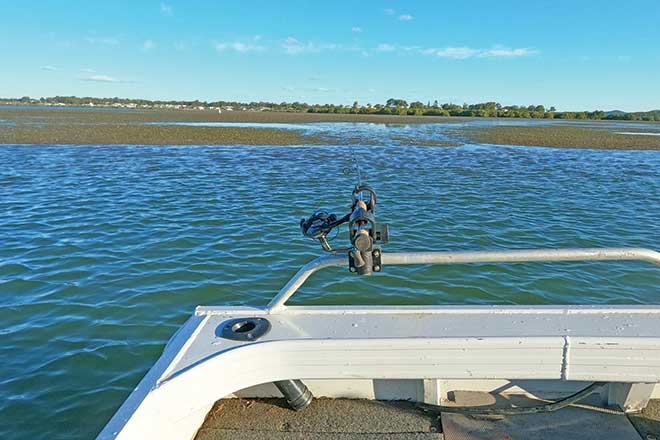With the successful Gold Coast Flathead Classic out of the way for another year, again the results speak for themselves.
Flathead are a great option on lures – be they hard-bodies or the ever-popular soft plastics.
However, what stood out for me as a distant observer was reading that the four top-placed teams in the Flathead Classic were all in smaller boats who did a lot of trolling!
Which is awesome because, in my view, it appears that trolling is making a comeback in southeast Queensland.
For me, since the 1990s boom, the trolling bug never went away, and I’ve continued to enjoy it to this day.
The other thing to note is that trolling the estuaries and inshore open bays – such as Moreton Bay – can be very successful, and not only for flathead but also mackerel, mangrove jack, snapper and more, including freshwater fish such as bass.
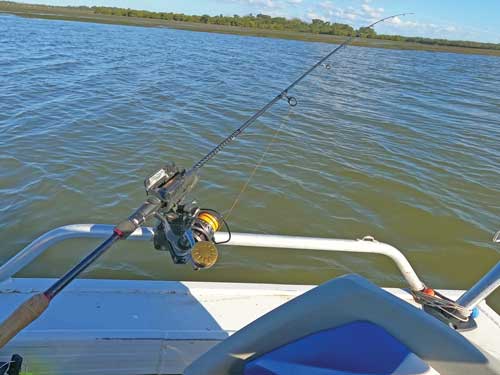
In fact, each trolling session, I usually end up with some by-catch of whiting, bream and trevally, and I’ve even caught a squid – all on small hard-bodies.
Why do I love trolling so much?
First and foremost, it’s the success.
You cover so much more ground trolling two or three lines behind your boat – putting your lures in front of fish you might not have found if you were throwing only soft plastics or drowning bait.
I also love the thrill of hearing the creak of the rod holder and then the screech of the reel as the rod buckles under the pressure of a fish on the other end!
Also, I prefer to fish actively rather than simply throwing a line out and hoping.

It’s a great way to learn about where the fish are – by watching your sounder closely, following map contours and water depth changes, taking note of your speed, water temperature, baitfish and even subtle changes to the water’s surface indicating different current flows.
Finally, active fishing puts you ‘in the moment’, which can be great for your mental health – helping to stop you worrying about issues that might otherwise be troubling you.
All that said, sometimes trolling can be one of the more frustrating fishing techniques.
On some days – usually after a few days of a strong northerly – the water can turn a dirty stained colour and be full of floating ribbon weed.
Continuing to remove weed from fouled trebles can drive even the most patient angler nuts!
Just be aware of this and avoid those days after a strong northerly.
For this reason, trolling during the morning can usually be best in the warmer months in southeast Queensland because a northerly tends to pick up around lunchtime.
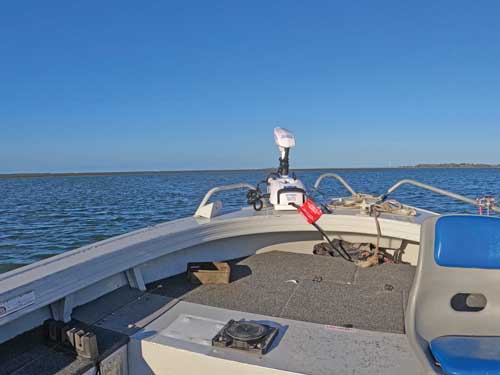
Small boats
Trolling lures for flathead in very shallow water is one of the key reasons I’ve always had a smaller shallower draft boat.
This allows you to get into super shallow water for flathead – about 0.6-0.9m depth.
The bonus is that in such shallow water, apart from using shallow-diving minnow hard-bodies, you can also troll soft plastics on 1/4-3/8oz successfully behind the boat.
In addition – while it’s very handy to have an electric motor in such water and you’ll probably catch more fish – you can still catch them using a reasonably quiet four-stroke and making sure your lures are a few boat lengths back from the boat.

I have certainly done this in water of 0.6-0.9m deep in the past.
However, after purchasing a new Watersnake Geo-Spot electric motor recently, the biggest advantage I find is that you can lock in your speed and direction, and move about the boat without altering your direction.
Further, when you hook-up to a fish, if you have other rods out, you can either keep trolling forward or, when you’re on your own, put the boat in spot-lock to try reducing the risk of tangles with other rods.
Yet another feature of this electric is that you can record trolling routes, where you might weave in and out following the contours of the estuary bottom.
Once recorded, you can follow that route hands-free.
This is a great option, particularly if you’ve caught fish there that day or previously.
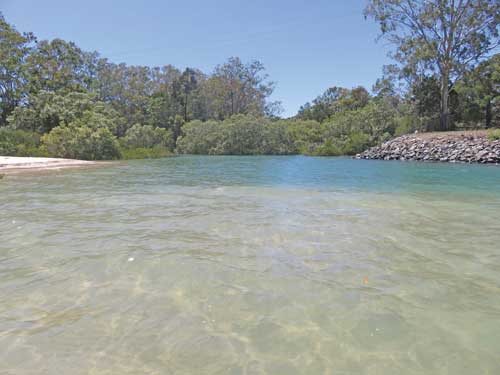
Target areas
Top spots to troll on the falling tide include along the edge of sand flats that drain into deeper water, along the front of creek mouths and shallow drains, alongside patches of ribbon weed on the sand flats that will hold bait, close to fallen timber in a creek, in front of rocky points and along the outer boundary of oyster leases.
On a rising tide, shallow drains deep enough to troll in are a good option and, as the tide approaches high, the edges of mangroves can be a great opportunity.
Other good high tide options are shallow bays that are only accessible on a high tide.
I’ve had some amazing fishing in such water – especially on a big tide around a full or a new moon period – because more water pushes into them, giving access to a smorgasbord of bait, often predator-free on lower tides.
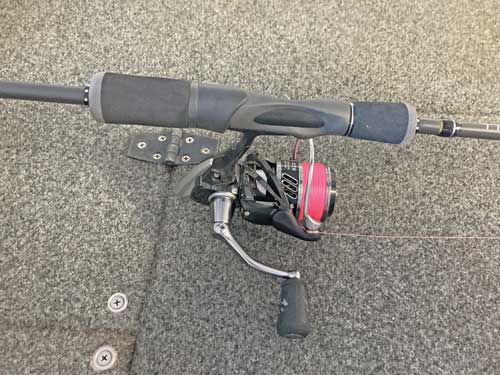
Another tip is to pull your electric motor up – or simply start your four-stroke if you don’t have an electric – and motor between target areas, rather than waste your time trolling the barren grounds between them.
By barren grounds, I’m referring to areas such as hard featureless sand and spots free of any structure.
These are devoid of bait such as yabbies and worms.
Look instead for the soft darker sand that is full of yabbies, soldier crabs and worms.
Looking at the bottom through polaroid glasses is a great way to spot the best target areas.
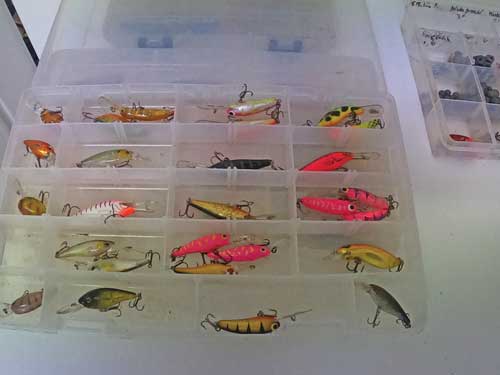
Tackle tactics
For those who haven’t tried trolling before, keep the light whippy fibreglass whiting rods at home.
Instead, you want to be using high modulus graphite rods in about 7’-7’6” with a medium-fast action – that is, just enough flex in the tip of the rod to transfer the action of the lure but not too whippy so that the rod tip absorbs any action of the lure being pulled through the water.
Any experienced fishing tackle salesperson should be able to show you through the different options for one with just the right amount of action in the tip of the rod when trolling.
If they can’t, try somewhere else.
The tip action should be subtle enough that as soon as the lure catches any weed, the lack of action of the lure in the water will be transferred up through the braid to the rod tip and show that the lure is fouled and needs shaking off or retrieved and removed.
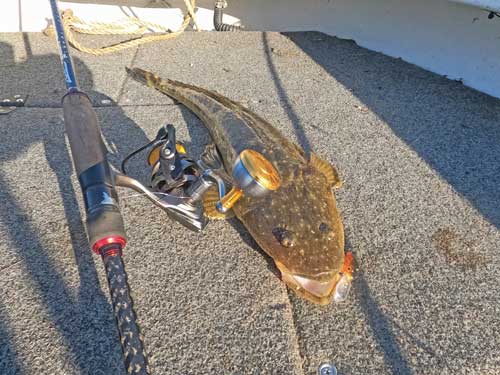
When it comes to reels, small reels in the 1000-2000 size range are perfect to balance the graphite rods mentioned and the type of braid recommended below.
Be sure to set your drag so the line comes off under a bit of pressure to set the hooks but not too tight that the hooks can pull from the fish’s mouth on hook-up.
Bright braided line is a big advantage when trolling, so you can see where your lines are to avoid them tangling each other.
The other advantage of braid is that the stretch-free line shows the action of the lure better on your rod tip and will also mean any hits on your lure aren’t absorbed through the stretch of monofilament line.
In shallow to mid-water depth, I find 6lb braid is more than enough and I’ll vary my leader according to water colour and depth, but generally run 3m of between 10-14lb clear fluorocarbon leader at the business end of the line connecting the lure.
In deeper water, you might go up to 8-10lb braid and 14-16lb leader.

Lure depth
Choosing the right lure for the water depth you are fishing is also critical.
When trolling for flathead using hard-bodies, you want to be regularly hitting the bottom where the fish will be laying in ambush.
Hitting the bottom regularly will also be throwing up little puffs of sand and mud, attracting the attention of the fish.
Having a range of lures that dive to different depths helps you cover a variety of options, even in terms of a spread of lures in your boat while you troll.
As an example, when I’m trolling along the edge of a drop-off, I’ll have a shallower-diving lure on the inside and a deeper-diving lure on the outside in the deeper edge.
I also run a deep-diving lure close to the boat – say a boat length – to stir sand and mud up and attract fish to the lures behind it.
Occasionally it will be taken too.
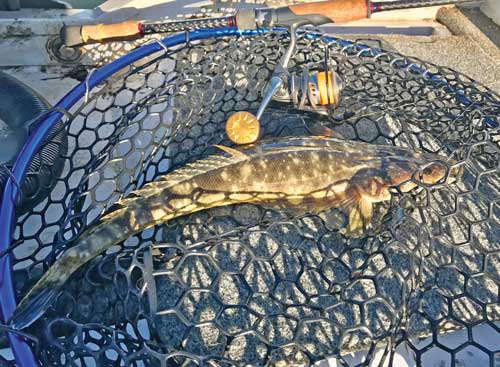
Regarding the length back from the boat for the other lures, I’ve experimented with lures up to 25-30m back from the boat previously, though I’ve found that a range of between 1.5-3.5 boat lengths tends to work well.
You can also have one shorter and one further back to mix your options up.
Another trick when you’re in water perhaps too shallow for your lure is to, rather than changing them over to a shallower lure, first try angling your rod holder upwards so the lure isn’t running hard into the bottom and at risk of getting fouled up.
On the other hand, if the water is a bit deeper, try angling your rod holder down and thus getting your lure deeper.
Lure colour
Lure colour is personal preference, however the key is trying to match the water colour.
In winter, the water can become very clear, so you want to be using clear colours, light greens, blues and whites.
Pinks are an all-water colour favourite of mine too.
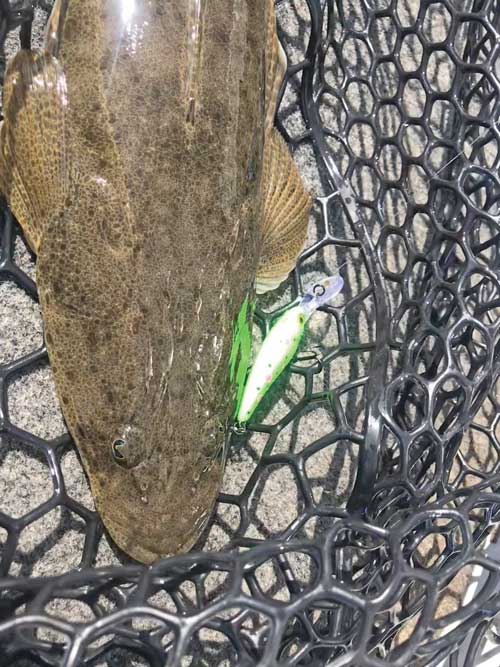
After rain, discoloured water calls for darker hard-body colours, fluorescent colours in greens, pinks and oranges and lures that have added ultraviolet that make them stand out in the dirty water.
So, there you go.
A few tips and tricks to get you started or to improve your trolling for flathead results.
For more tips and reports, follow my social media pages on Facebook, YouTube or Instagram @Ontour Fishing Australia.
 Bush 'n Beach Fishing Magazine Location reports & tips for fishing, boating, camping, kayaking, 4WDing in Queensland and Northern NSW
Bush 'n Beach Fishing Magazine Location reports & tips for fishing, boating, camping, kayaking, 4WDing in Queensland and Northern NSW
